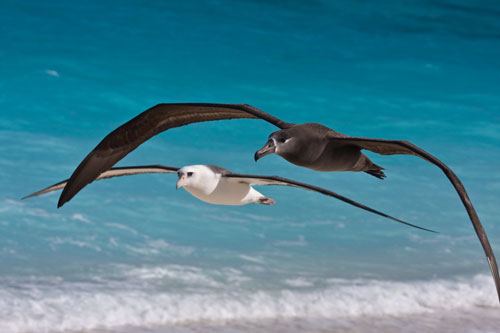Noting that all albatrosses and petrels listed by ACAP are migratory species, the following text is taken from the World Migratory Bird Day website for information purposes.
“In times of ever-increasing global demand for energy, developing new and expanding existing renewable energy technologies are key when striving towards a low carbon future. Yet energy cannot be truly sustainable and nature-friendly unless it fully takes biodiversity and, more specifically, migratory birds into consideration. With the theme “Energy – make it bird-friendly!”, World Migratory Bird Day (WMBD) 2015 aims to highlight the importance of deploying energy technologies in a way that prevents, minimizes and mitigates impacts on migratory birds and their habitats.
Every year, millions of migratory birds struggle with the massive expansion of various means of generating and distributing energy: collisions and electrocution due to power lines as well as barrier effects from energy infrastructure are causing mortality and displacement. In addition, the birds suffer effects from habitat loss and degradation and other disturbances from the deployment of hydropower, bio-energy, ocean, solar, wind and geothermal energy technologies. Sustainable renewable energy production is expected to have positive effects on migratory birds by mitigating climate change and its impacts. However, if certain energy technologies are deployed without proper planning, design and risk assessment, they can pose a grave threat to migratory bird species.
When expanding energy production, transition to wildlife-friendly methods is a key step to protect life on the Earth. The conservation of migratory birds needs to be considered in all phases of energy development at multiple levels - locally, nationally and internationally. Therefore, concerted conservation actions by governments, nature conservation organizations, scientists and the energy sector as well as the general public are necessary. This way the benefits of sustainable energy can be realized without the risk of harming migratory birds and their habitat."

Laysan and Black-footed Albatrosses - migratory species of the North Pacific, photograph by Eric Vanderwerf
"Launched in 2006 World Migratory Bird Day is an awareness-raising campaign which is celebrated annually and aims to inspire the worldwide conservation of both migratory birds and their habitats. This campaign is organized by two international wildlife treaties administered by the United Nations Environment Programme (UNEP) - the Convention on the Conservation of Migratory Species of Wild Animals (CMS), and the Agreement on the Conservation of African-Eurasian Migratory Waterbirds (AEWA).
You can learn more about World Migratory Bird Day, register your event and order posters, stickers and postcards on the WMBD website as well as share your activities with the growing community behind WMBD across the globe.”
John Cooper, ACAP Information Officer, 10 May 2015

 English
English  Français
Français  Español
Español